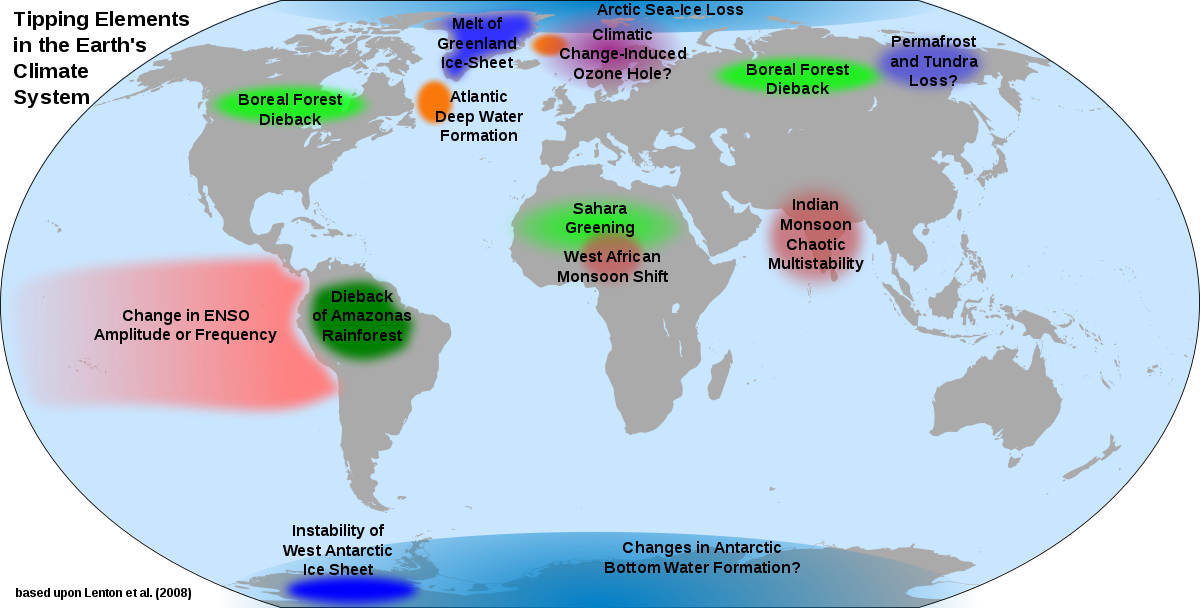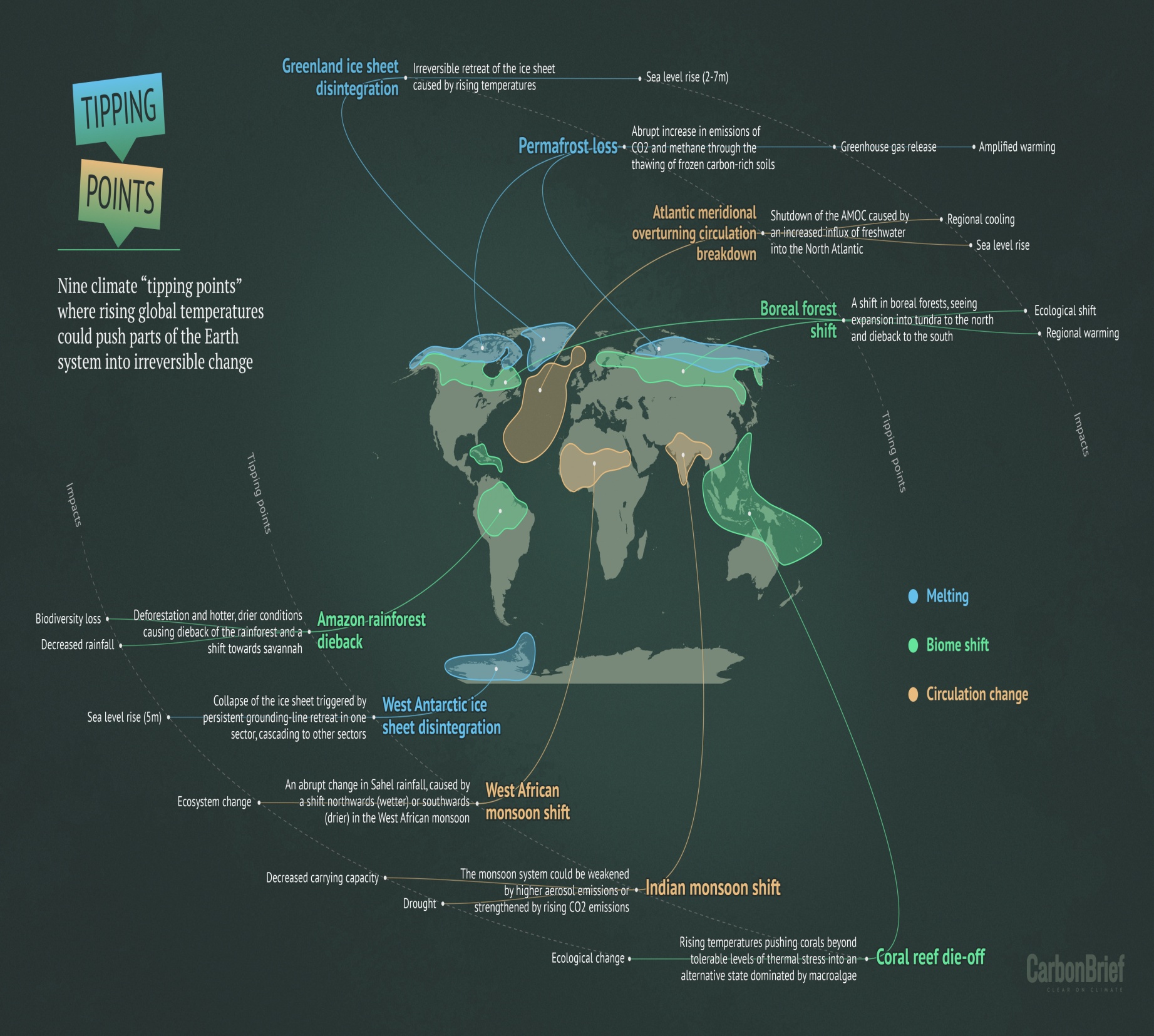Description

Disclaimer: Copyright infringement not intended.
In News
- The Indian Summer Monsoon (ISM) and the West African Monsoon (WAM) are undergoing adverse changes due to global warming. So much so that both these systems have been included under global climate tipping points.
Global tipping points
- A tipping point in the climate system is a critical threshold that, when exceeded, leads to large and often irreversible changes in the state of the system. The term 'tipping point' is used by climate scientists to identify vulnerable features of the climate system
- Disruption of one climate tipping point could lead to disruption of other climate tipping points as well, forming a cascade.
- The concept of tipping points was introduced by the IPCC 20 years ago, but then it was thought they would only occur if global warming reached 5°C.
- Recent IPCC assessments, however, suggested that tipping points could be reached between 1°C and 2°C of warming.
Major Climate Tipping Points
Greenland ice sheet
- The Greenland ice sheet contains enough water to raise global sea levels by over 20 feet and its melting is accelerating. From 1992 to 2018, it lost close to four trillion tons of ice. While its disintegration is not likely to be abrupt, there could come a point beyond which its eventual collapse is irreversible for millennia.
- Scientists speculated that the critical temperature range at which the Greenland ice sheet would go into irreversible disintegration is between 0.8°C and 3.2°C of warming above pre-industrial levels.
The West Antarctic Ice Sheet (WAIS)
- A 2018 study found that the WAIS went from ice loss of almost 58.5 billion tons a year between 1992 and 1997 to 175 billion tons from 2012 to 2017.
- The Thwaites Glacier on West Antarctica’s Amundsen Sea has lost a trillion tons of ice since the early 2000s, and scientists believe it could be headed for an irreversible collapse, which could threaten a large part of the WAIS and raise global sea levels by two feet or more.
- The Pine Island glacier, also on the Amundsen Sea, is thinning rapidly as well.
- Antarctica as a whole contains enough ice to raise global sea levels by over 200 feet.
Atlantic Meridional Overturning Circulation (AMOC)
- The AMOC is one of the main global ocean currents and is critical to regulating climate. Cold salty water, which is dense and heavy, sinks deep into the ocean in the North Atlantic, and moves along the bottom until it rises to the surface near the equator, usually in the Pacific and Indian Oceans.
- Heat from the sun then warms the water, and evaporation leaves the water saltier. The warm salty water travels up the coast via the Gulf Stream, warming the U.S. East Coast and Western Europe.
- Once the water releases its heat and reaches the North Atlantic, it becomes cold and dense again, and the cycle, which can take water 1,000 years to complete, continues.
- But as glaciers and ice sheets melt, they add fresh, less dense water to the North Atlantic, which prevents the water from sinking and impedes circulation.
- This is why AMOC has slowed 15 percent since the 1950s.
- If the AMOC shuts down, it would cause significant cooling along the east coast of the U.S. and Western Europe. This, in turn, would alter rainfall patterns, make sea levels rise, cause more drying, and reduce agriculture in the U.K. It could also potentially set off other tipping points.

Amazon rainforest
- Because of logging, ranching, mining, agriculture, and fires, the Amazon has lost about 17 percent of its tree cover and at the current rate of deforestation, could reach a loss of 27 percent by 2030.
- If 20-25 percent of the Amazon were deforested, its tipping point could be crossed, according to one study.
Thawing permafrost
- Permafrost is ground that remains frozen for two or more consecutive years and is composed of rock, soil, sediments, and ice. Some permafrost has been frozen for tens or hundreds of thousands of years.
- Fourteen hundred billion tons of carbon are frozen in the Arctic’s permafrost, which is twice as much carbon as is currently in the atmosphere.
- But the Arctic is warming two times faster than the rest of the planet—it has already warmed 2°C above pre-industrial levels.
- As it warms and thaws the permafrost, microbes come out of hibernation and break down the organic carbon in the soil, releasing CO2 and methane, which then trigger even more warming and melting.
ENSO
- El Niño and La Niña are the warm and cool, naturally occurring weather patterns across the tropical Pacific—the El Niño-Southern Oscillation, or ENSO.
- Every two to seven years, the pattern alternates, bringing disruptions in temperature and precipitation.
- El Niño causes impacts around the world, such as more drought in India, Indonesia and Brazil, and flooding in Peru. As the ocean warms, it could push ENSO past a tipping point, which would make El Niño events more severe and frequent and could increase drought in the Amazon.
Tipping point interactions
- A recent study of the WAIS, the Greenland ice sheet, the AMOC, ENSO, and the Amazon rainforest tipping points found that they could interact with one another before temperatures reach 2°C.
- This interaction would enable tipping to occur at lower thresholds than previously expected. The risk analysis found that a cascade could potentially begin with the melting of the ice sheets because their critical thresholds are lower.
- For example, as the Greenland ice sheet releases fresh water into the North Atlantic, the AMOC could slow.
- This would result in less heat being transported towards the north. As the North got colder, it could potentially help stabilize the Greenland ice sheet.
- However, it would also result in warmer water in the Southern Ocean and this could lead to more drought in some parts of the Amazon while others get more rainfall.
- Changes in the AMOC could also trigger changes in ENSO, leading to a more permanent El Niño state, whose impacts could lower the critical threshold for Amazon dieback.
Effects of Tipping Points
- If the climate tips into a state where tipping points begin to cascade, coastal storms will have greater impact, hundreds of millions of people will be displaced by rising sea levels, there will be food and water shortages, and people will die from unhealthy heat levels and generally unlivable conditions.
- It has the potential to trigger collapse of the current societal organization and set the stage for massive unrest and global conflict.
- If cascading tipping points lead to climate temperature increases of 4–5 °C, this will make swaths of the planet around the equator uninhabitable, and lead to sea levels up to 60 metres (197 ft) higher than they are today.
According to some scientists West African Monsoon, should not be regarded as a tipping element of the climate system.
Inclusion of Indian Summer Monsoon (ISM) and the West African Monsoon (WAM) as Tipping Points
Influence of the WAM on the ISM
- The WAM always has had the potential of impacting the Indian monsoon system. The circulation in the tropics is interconnected (walker circulation). Therefore, changes in circulation in one place are likely to affect circulation far afield due to an altered walker circulation.
- For example, changes in dust emission are a factor (reduced dust concentration will likely led to an increased sea surface temperature, hence higher Indian monsoon rainfall during the past).
- Another reason is linked to the above-mentioned impact on the Walker Circulation. For example, intensification of WAM leads to higher convergence over the western Indian Ocean and lower convergence over the Amazon (decreased rainfall).
Impact of WAM on ISM in future climate scenarios
- According to some scientists, thus WAM should not be regarded as a tipping element of the climate system as future projections show a possible weak intensification of the WAM in the future.
- Though changes in WAM would be able to dramatically impact local ecosystems its changes will be gradual enough for the local ecosystems to adapt.
- Current behavior of the WAM system should not be compared to Tipping Point or African Humid Period.
|
The African humid period (also known by other names) is a climate period in Africa during the late Pleistocene and Holocene geologic epochs, when northern Africa was wetter than today. The covering of much of the Sahara desert by grasses, trees and lakes was caused by changes in Earth's orbit around the Sun; changes in vegetation and dust in the Sahara which strengthened the African monsoon; and increased greenhouse gases.
|
- However, other factors may play a stronger role in altering the ISM intensity.
- The realization of the Great Green Wall in the Sahel region may strengthen the intensity of the WAM significantly and this may have a cascade effect on the ISM.
|
Great Green Wall
The Great Green Wall or Great Green Wall of the Sahara and the Sahel is a project led by the African Union, initially conceived as a way to combat desertification in the Sahel region and hold back expansion of the Sahara, by planting a wall of trees stretching across the entire Sahel. The modern green wall has since evolved into a program promoting water harvesting techniques, greenery protection and improving indigenous land use techniques, aimed at creating a mosaic of green and productive landscapes across North Africa.
|
https://www.downtoearth.org.in/interviews/climate-change/-the-west-african-monsoon-always-had-the-potential-of-impacting-the-indian-monsoon--82123











